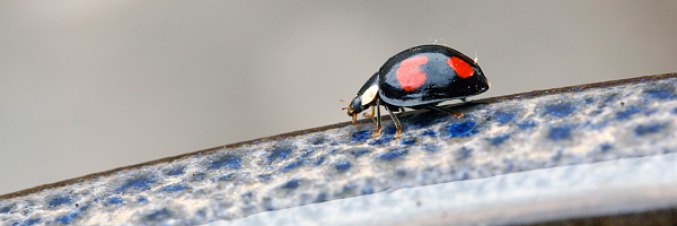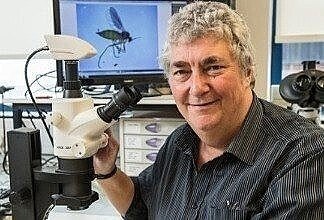
The Harlequin Ladybird - friend or foe?
5 Minute Read
Dr Ian Bedford tells us everything we need to know about the 'bug of the month' for February, the harlequin ladybird.Throughout the winter period, it shouldn’t be too uncommon to find insects inside our homes that we’ll be accustomed to seeing in the garden during the warmer growing seasons. Insects that will be lying dormant, away from the potentially lethal effects of winter’s weather until spring, when they’ll awaken and return to the garden.
Whilst some might be found individually behind the furniture or in the folds of a curtain, others could be found clustering together, perhaps amongst the rafters in the loft. For some of these insects, their overwintering clusters could be large, and comprise of many hundreds, or even thousands of individuals. And this is often the case with the non-native ladybird Harmonia axyridis, the Harlequin Ladybird, whose overwintering clusters are now a very common occurrence in homes and other buildings across Britain.
What is the Harlequin Ladybird?
Harlequin ladybirds originate from East Asia and are one of the most diversely coloured and patterned ladybirds in the world, which can make identifying them quite difficult. They’re also a voracious predator of aphids which resulted in them being bred and released within mainland Europe and North America to control aphids on commercial crops. These artificial introductions then enabled Harlequin ladybirds to spread to many other regions around the world.
Which included Britain, where they were first recorded in 2004.
Found to be rapidly establishing in a wide range of habitats, they initially caused concern that they would not only predate on and decimate many small native invertebrates, but out-compete Britain’s native ladybirds. However, more than 20 years later, these issues have not really become too evident, even though the Harlequin ladybird has now spread nationwide and become Britain’s most common ladybird species.

Could a potential risk still exist for Britain’s native biodiversity?
Well, there’s certainly no doubt that this ladybird has the propensity to predate on a significantly wider range of invertebrate species than Britain’s native ladybirds, and that it could potentially out-compete them where a food source is limited. But, considering the potential problems of global warming to species that have adapted to a temperate climate, the robust Harlequin’s will probably fare better and will be valued as an important natural enemy of many plant-damaging aphids.
Particularly aphids that are difficult to control on important crops, such as those that infest apple trees where their colonies develop within curled leaves that protect them from chemical sprays, but not from the efficient foraging and lethal mandibles of the adult and juvenile ladybirds.
Despite the bad press that the Harlequin ladybird attracted when it first appeared in Britain, it should now be recognised as one of the country’s resident species with a role to play within the ecosystem. It certainly shouldn’t be considered as a pest that requires controlling. However, the overwintering clusters of Harlequin ladybirds might be considered a nuisance when inside a home. In these cases, gently sweeping the ladybirds into a container using a soft brush will enable them to be relocated to somewhere more suitable where they will be protected from frosts.

About Dr Ian Bedford
Ian has been fascinated by the bug world for as long as he can remember. From studying butterflies on the South Downs as a youngster, he went on to pursue a career in Research Entomology and ran the Entomology Dept at the John Innes Centre in Norwich up until his recent retirement.VISIT WEBSITE

'Bug of the month'
Visit our 'bug of the month' archive.
Every month Ian will share his knowledge on how to protect your plants and gardens from preventable pest invasions while providing valuable insights into the insects regularly found in our gardens.
find out more
Comments (0)
Why not be the first to send us your thoughts?
Leave A Comment
Most popular articles
1
Plastic plant pots dimensions and uses2
Peat vs Peat Free - Choosing the right Potting Compost3
How to Grow Watercress at home in plant pots4
January Jobs5
Our guide to seed sowing compost